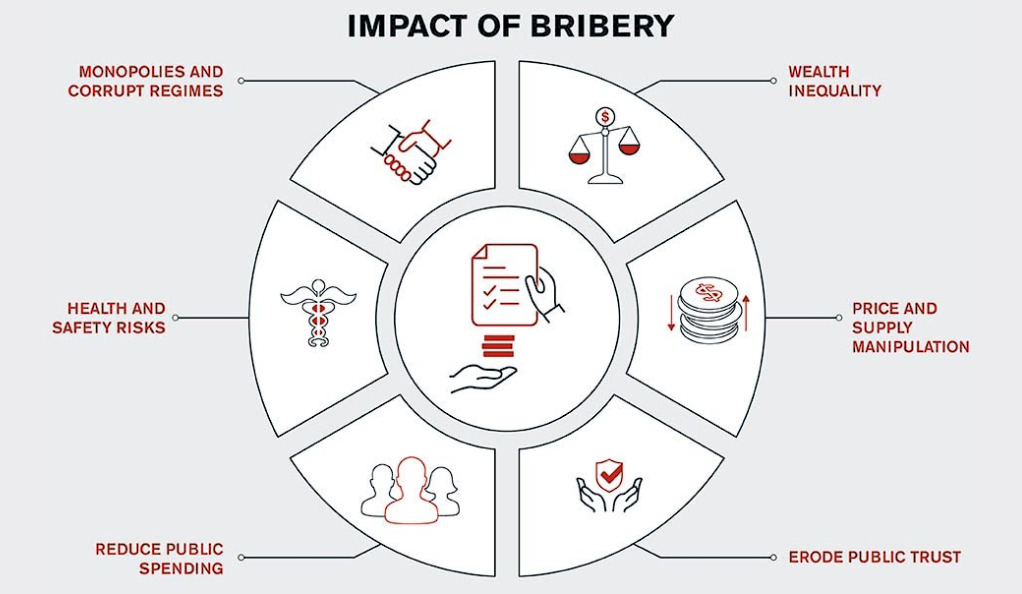Banking bribery schemes, often hidden in the shadows of the global financial system, are illicit arrangements where individuals or entities offer, give, receive, or solicit something of value to influence the actions of bank officials or related parties. These schemes can range from small-scale frauds to massive operations involving billions of dollars, and they have far-reaching implications not only for the institutions involved but also for the global economy at large.
The Anatomy of a Banking Bribery Scheme
At its core, a banking bribery scheme typically involves two main parties: the ‘giver’ and the ‘receiver’. The ‘giver’ offers something of value, which could be money, gifts, or other favors, to the ‘receiver’ in exchange for some form of preferential treatment. This could be in the form of approving a loan, manipulating financial data, or overlooking certain regulatory checks.
Common Elements in a Banking Bribery Scheme
| Element | Description |
|---|---|
| Bribe Giver | Often a corporate entity or individual seeking undue advantage. |
| Bribe Receiver | Typically a bank official or someone in a position of power within the financial institution. |
| Bribe | Can be money, gifts, holidays, or any other form of undue advantage. |
| Objective | The desired outcome, e.g., loan approval, regulatory leniency, etc. |
The Global Impact of Banking Bribery
The repercussions of these schemes are vast and varied:
- Economic Distortions: They can lead to misallocation of resources, where decisions are made based on bribes rather than economic merit. This can result in bad loans, unwise investments, and ultimately financial crises.
- Loss of Trust: Public trust in financial institutions diminishes, leading to reduced investments and economic downturns.
- Regulatory Backlash: As these schemes come to light, regulatory bodies often respond with stricter regulations, which can increase the cost of compliance for all banks, even those not involved in bribery.

The Significance of Addressing Banking Bribery
Addressing and curbing banking bribery is of paramount importance for several reasons:
- Economic Stability: A transparent and fair banking system is foundational for economic growth and stability.
- Investor Confidence: Investors are more likely to invest in countries and institutions they perceive as clean and free from corruption.
- Social Justice: Bribery often results in the rich getting richer at the expense of the general populace. Addressing it is a step towards a more equitable society.
Comparison Table: Impact of Addressing vs. Ignoring Banking Bribery
| Aspect | Addressing Bribery | Ignoring Bribery |
|---|---|---|
| Economic Growth | Positive, as resources are allocated based on merit. | Stunted, due to misallocation of resources. |
| Public Trust | High, leading to more investments and economic activities. | Low, leading to economic downturns and reduced investments. |
| Regulatory Environment | Proactive, with regulations that are fair and not overly punitive. | Reactive, with potentially harsh regulations introduced in response to scandals. |
Historical Context of Banking Bribery Schemes
The history of banking is, unfortunately, intertwined with instances of bribery and corruption. From ancient civilizations to modern financial hubs, bribery schemes have evolved in complexity, scale, and impact. Understanding this historical context provides a clearer picture of the challenges faced today and the lessons learned from past misdeeds.
Notorious Banking Bribery Cases Through the Ages
The Medici Bank (15th Century)
One of the earliest and most influential banks in the world, the Medici Bank of Renaissance Italy, was not immune to allegations of bribery. The Medici family, while known for their patronage of the arts, also used their financial power to influence political decisions, often through questionable means.
The South Sea Bubble (1720)
The South Sea Company, in an attempt to monopolize trade routes, was involved in one of the first major stock market crashes. Key to this disaster was the bribery of members of the British aristocracy and even the royal family to endorse and inflate the company’s value.
BCCI Scandal (1991)
The Bank of Credit and Commerce International (BCCI) was embroiled in a massive scandal involving money laundering, bribery, and support of terrorism. With operations in 78 countries and assets over $20 billion, its closure was a significant event in banking history.
The 1MDB Scandal (2015)
As mentioned earlier, the 1Malaysia Development Berhad (1MDB) scandal involved the misappropriation of billions of dollars, with funds being laundered through the global financial system. High-ranking officials in Malaysia and the United Arab Emirates were implicated, and the scandal had repercussions for banks and financial institutions worldwide.
The Evolution of Bribery Schemes
Ancient and Medieval Times. In ancient civilizations, bribery was often straightforward, involving direct payments to officials to overlook regulations or grant favors. Gold, land, and other tangible assets were the primary currencies of bribery.
The Age of Exploration and Colonialism. As global trade routes expanded, so did the opportunities for bribery. Companies vied for monopolistic control over lucrative trade routes, often resorting to bribing local chieftains or colonial administrators.
Industrial Age to Early 20th Century. The rise of industrial magnates and the expansion of global banking saw more sophisticated bribery schemes. Offshore accounts, shell companies, and complex financial instruments became tools for masking illicit transactions.
Late 20th Century to Present. Modern bribery schemes often involve digital transactions, making them harder to trace. However, advancements in forensic accounting, international cooperation, and whistleblower protections have also improved the detection and prosecution of such activities.
Evolution of Bribery Tools Over the Ages
| Era | Primary Tools of Bribery |
|---|---|
| Ancient Times | Gold, land, tangible assets |
| Age of Exploration | Trade monopolies, direct payments |
| Industrial Age | Offshore accounts, shell companies |
| Modern Era | Digital transactions, complex financial instruments |
Mechanisms of Banking Bribery
Banking bribery, a clandestine operation often buried deep within layers of financial transactions, is a sophisticated endeavor that requires intricate planning and execution. The mechanisms behind these schemes have evolved over time, adapting to the ever-changing landscape of global finance. Central to these operations are high-ranking officials and corporate insiders, whose positions of power and influence are exploited to facilitate these illicit activities.

Orchestrating a Banking Bribery Scheme
Identification of Targets
The first step often involves identifying individuals or entities that can be influenced. This could be a bank official responsible for approving loans, a regulator overseeing banking operations, or even politicians who can sway financial policies.
Establishing Communication Channels
Discreet communication channels are established, ensuring that conversations and transactions remain hidden. This could involve encrypted messaging platforms, face-to-face meetings in undisclosed locations, or even using intermediaries to relay messages.
Transaction Mechanisms
The actual transfer of bribes has become increasingly sophisticated. Methods include:
- Shell Companies: Entities created to disguise the true source and destination of funds.
- Offshore Accounts: Bank accounts in jurisdictions with strict bank secrecy laws, making it difficult to trace the origins of funds.
- Over-invoicing or Under-invoicing: Manipulating the price of goods or services to move money illicitly.
- Hawala System: An informal and ancient system of transferring money based on trust, prevalent in some parts of the world.
Layering and Integration
To further obscure the origins of illicit funds, multiple transactions are conducted across various banks and countries, a process known as layering. Once sufficiently “distanced” from their source, these funds are then integrated into the legitimate financial system, appearing as legal assets.
The Role of High-Ranking Officials and Corporate Insiders
- Access to Critical Information: These individuals often have access to confidential information, giving them insights into regulatory checks, internal audits, and upcoming policy changes. This knowledge can be invaluable in planning and executing bribery schemes.
- Influence Over Decisions: High-ranking officials can sway decisions in favor of those offering bribes. This could involve approving questionable loans, overlooking regulatory violations, or even influencing the drafting of financial policies.
- Facilitation of Transactions: Corporate insiders, especially those in pivotal roles like treasury or compliance, can facilitate illicit transactions, ensuring they go unnoticed or are masked as legitimate.
- Damage Control: In the event of suspicions or investigations, these individuals can manipulate internal reports, influence internal audits, or even stall external investigations, providing time to cover tracks or adjust strategies.
Role of Officials in Bribery Schemes
| Role | Function | Impact |
|---|---|---|
| Bank Official | Approve loans, manipulate interest rates | Direct financial gains for bribe-givers |
| Regulator | Overlook violations, influence policies | Regulatory leniency, policy advantages |
| Corporate Insider | Facilitate illicit transactions, manipulate reports | Concealment of bribery, evasion of detection |
Global Repercussions of Banking Bribery Schemes
Banking bribery schemes, while often initiated by individuals or specific entities, have ripple effects that extend far beyond their immediate sphere of operation. These illicit activities can destabilize economies, strain international relations, and erode the public’s trust in financial institutions. The global implications of such schemes underscore the importance of understanding and addressing them..
Impact on Global Economies
- Economic Distortions: Banking bribery can lead to a misallocation of resources. Decisions influenced by bribes, rather than economic merit, can result in bad loans, unwise investments, and even financial crises. Countries may see skewed economic growth, favoring sectors or industries that are involved in bribery over those that are not.
- Reduced Foreign Investments: Countries perceived to have rampant banking bribery may become less attractive to foreign investors. The unpredictability and perceived risk associated with such environments can deter investments, slowing economic growth.
- Currency Fluctuations: Large-scale bribery schemes can lead to significant capital flows in and out of countries, causing currency value fluctuations. This can impact trade balances, inflation rates, and overall economic stability.
Strain on International Relations
Diplomatic Tensions: Revelations of bribery involving officials from multiple countries can strain diplomatic ties. Countries may be accused of harboring or protecting individuals involved in bribery, leading to tensions or even sanctions.
Trade Implications: Countries embroiled in bribery scandals may face trade restrictions or boycotts, impacting their export-import dynamics and potentially leading to trade deficits.
International Legal Battles: Bribery schemes that span multiple countries can result in complex international legal battles. Extradition requests, asset seizures, and international arbitration can strain relations and resources.
Undermining of Public Trust
- Loss of Faith in Financial Institutions: When major banks or financial institutions are implicated in bribery schemes, the public’s trust in these entities diminishes. This can lead to reduced deposits, stock value drops, and even bank runs in extreme cases.
- Skepticism Towards Regulatory Bodies: If regulatory bodies are perceived as being complicit or ineffective in preventing bribery, the public may lose faith in their ability to safeguard the financial system.
- General Cynicism: Repeated instances of banking bribery can foster a sense of cynicism among the public, leading to decreased engagement in financial and civic activities. People may feel that corruption is inevitable, reducing their motivation to seek change or hold entities accountable.
Global Repercussions of Banking Bribery
| Repercussion | Description | Potential Impact |
|---|---|---|
| Economic Distortions | Misallocation of resources due to bribery-influenced decisions | Financial crises, skewed economic growth |
| Diplomatic Tensions | Strained relations due to cross-border bribery incidents | Sanctions, reduced diplomatic cooperation |
| Loss of Public Trust | Eroded faith in banks and regulators | Bank runs, reduced civic engagement |
Efforts to Combat Banking Bribery
The pervasive nature of banking bribery schemes, coupled with their detrimental global repercussions, has necessitated concerted efforts to combat these illicit activities. From international collaborations to internal checks within financial institutions, various strategies have been employed to detect, prevent, and penalize bribery. Central to these efforts are international law enforcement agencies, robust internal controls, and the brave whistleblowers who bring such schemes to light.
International Cooperation and Law Enforcement Initiatives
Treaties and Conventions
Several international treaties aim to combat corruption and bribery. Notable among these is the OECD Anti-Bribery Convention, which mandates member countries to criminalize bribery of foreign public officials in international business transactions.
Joint Task Forces
Countries often form joint task forces to investigate and combat cross-border bribery schemes. These task forces facilitate the sharing of intelligence, resources, and expertise.
Asset Freezing and Recovery
International cooperation has enabled the freezing and recovery of assets obtained through bribery. Organizations like the Stolen Asset Recovery Initiative (StAR), a partnership between the World Bank Group and the United Nations, assist countries in recovering stolen assets.
Extradition Agreements
Countries collaborate to extradite individuals implicated in bribery schemes, ensuring they face justice even if they flee their home country.
The Role of Internal Controls
- Compliance Programs: Financial institutions are increasingly investing in robust compliance programs that monitor transactions, identify red flags, and ensure adherence to anti-bribery laws.
- Regular Audits: Regular internal and external audits help in detecting discrepancies that might indicate bribery or other illicit activities. These audits provide an additional layer of oversight and scrutiny.
- Employee Training: Banks and financial institutions often conduct training programs to educate employees about the risks of bribery, the importance of ethical conduct, and the mechanisms to report suspicious activities.
- Technology and AI: Advanced technologies, including artificial intelligence, are being employed to monitor and analyze vast amounts of transaction data, helping in the early detection of potential bribery schemes.
Whistleblowers: The Unsung Heroes
Reporting Mechanisms. Many institutions have established secure and anonymous reporting mechanisms, allowing whistleblowers to report bribery without fear of retaliation.
Legal Protections. Countries are increasingly enacting laws to protect whistleblowers from harassment, job loss, and other forms of retaliation.
Financial Incentives. In some jurisdictions, whistleblowers are offered financial rewards for providing information that leads to the successful prosecution of bribery cases.
Key Strategies to Combat Banking Bribery
| Strategy | Description | Impact |
|---|---|---|
| International Treaties | Agreements between countries to criminalize and combat bribery | Standardized global approach to bribery |
| Compliance Programs | Internal systems to monitor and prevent bribery | Early detection and prevention of illicit activities |
| Whistleblower Protections | Mechanisms to protect and incentivize whistleblowers | Encourages reporting of bribery, leading to increased detection |
The Future of Banking Integrity
As the global financial landscape continues to evolve, so does the commitment to banking integrity. The scars of past bribery schemes serve as stark reminders of the need for vigilance, innovation, and proactive measures to safeguard the financial sector. Looking ahead, banks are adopting a multifaceted approach, leveraging technology, especially artificial intelligence (AI), to ensure a future where financial transactions are transparent, ethical, and devoid of corrupt practices.
Proactive Measures by Banks
- Enhanced Due Diligence: Banks are intensifying their due diligence processes, especially for high-risk clients and transactions. This involves a deeper scrutiny of clients’ backgrounds, sources of funds, and the nature of their transactions.
- Strengthened Compliance Frameworks: Financial institutions are bolstering their compliance departments, ensuring they are equipped with the latest tools, training, and resources to monitor and enforce anti-bribery regulations.
- Employee Ethics Training: Recognizing that the fight against bribery begins from within, banks are investing in regular ethics training for employees, emphasizing the importance of integrity and the consequences of bribery.
- Collaborative Initiatives: Banks are increasingly collaborating, sharing information, best practices, and intelligence to collectively combat bribery schemes. Industry forums and associations play a pivotal role in facilitating such collaborations.
Conclusion
In conclusion, in the intricate tapestry of the global financial landscape, two pillars stand out as paramount: transparency and integrity. The banking sector, the lifeblood of economies worldwide, thrives on the trust placed in it by millions. This trust, however, is not a given; it is earned through consistent demonstrations of transparency in operations and unwavering commitment to ethical practices.
Reflecting on the myriad challenges the sector has faced, from high-profile bribery scandals to subtle internal compromises, it becomes evident that the path to integrity is fraught with temptations and pitfalls. Yet, it is this very journey, with its trials and tribulations, that underscores the importance of steadfast dedication to ethical principles. Every instance of corruption unveiled, every whistleblower’s revelation, and every regulatory intervention serves as a reminder of the delicate balance that needs to be maintained.
The battle against corruption in the financial world is ongoing. It is a battle fought not just in courtrooms or boardrooms but in the daily decisions of bank employees, in the policies set by institutions, and in the vigilance of the public. As technology advances and the world becomes more interconnected, new challenges will undoubtedly arise. However, armed with lessons from the past and a collective commitment to a transparent future, the banking sector is well-equipped to face these challenges head-on.








